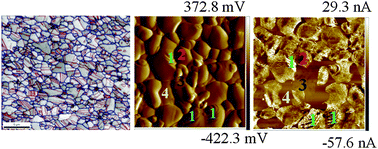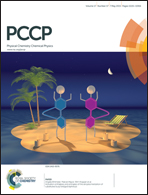Enhanced electrical properties at boundaries including twin boundaries of polycrystalline CdTe thin-film solar cells†
Abstract
The effect of grain boundaries (GBs), in particular twin boundaries (TBs), on CdTe polycrystalline thin films is studied by conductive atomic force microscopy (C-AFM), electron-beam-induced current (EBIC), scanning Kelvin probe microscopy (SKPM), electron backscatter diffraction (EBSD), and scanning transmission electron microscopy (STEM). Four types of CdTe grains with various densities of {111} Σ3 twin boundaries (TBs) are found in Cl-treated CdTe polycrystalline thin films: (1) grains having multiple {111} Σ3 TBs with a low angle to the film surface; (2) grains having multiple {111} Σ3 TBs parallel to the film surfaces; (3) small grains on a scale of not more than 500 nm, composed of Cd, Cl, Te, and O; and (4) CdTe grains with not more than two {111} Σ3 TBs. Grain boundaries (including TBs) exhibit enhanced current transport phenomena. However, the {111} Σ3 TB is much more beneficial to micro-current transport. The enhanced current transport can be explained by the lower electron potential at GBs (including TBs) than the grain interiors (GIs). Our results open new opportunities for enhancing solar cell performances by controlling the grain boundaries, and in particular TBs.


 Please wait while we load your content...
Please wait while we load your content...